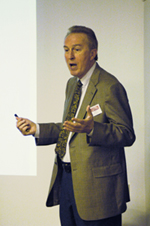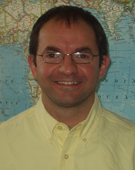Dr Paolo Zannetti from The EnviroComp Institute, USA presented a short course entitled ‘Air Quality: Management, Modelling and Forecasting’ and Dr Luca Delle Monache from the National Center for Atmospheric Research, USA also presented several lectures to the participants.
Over a period of three days, lectures were presented on the following topics:
- Introduction to Air Pollution Issues
- Scientific Understanding of Air Pollution Phenomena
- Air Quality Management in the US
- Air Quality Management in Europe
- Health Risks and Other Adverse Effects of Air Pollution
- Emergency Preparedness and Response - Case Studies
- Air Quality Modelling and Software
- Air Quality Management Tools and Software
- Introduction to Air Quality Forecasting
- Deterministic and Probabilistic Air Quality Predictions
- Chemical Data Assimilation
- Postprocessing and Calibration of Air Quality Predictions
This three-day course covered the most important issues related to the management of air quality problems, with emphasis on the US and European regulations and experience.
On the first day, participants were introduced to the main issues related to air pollution, covering: historical perspectives, a review of air pollution levels throughout the world, the role and importance of laws and regulations, and the engineering challenge of achieving substantial reduction in air pollution levels by emission controls and new technologies. Moreover, the current scientific understanding of air pollution phenomena was examined, with discussion about the physical laws (e.g., atmospheric turbulence) and chemical transformations (e.g., photochemical smog and secondary aerosols). The discussion on the first day concluded with a description of air quality management practices and regulations in the US and Europe.
On the second day, the objective quantification of the adverse effects of air pollution (e.g., the impact on human health) and the available formulations used for assessing adverse effects and optimization of emission controls in order to achieve maximum benefits was covered. Also, the issue of emergency preparedness and emergency response was discussed, with the presentation of case studies and the analysis of actual episodes of accidental releases of plumes from fires and industrial accidents. Finally, the available software to be used for simulating air pollution and its adverse impacts, together with air quality management software was presented.
The third day lectures focussed on air quality real-time predictions. First an introduction on state-of-the-science capabilities was given, followed by a review of the activities of the main operational centres around the world. Then a detailed analysis of current deterministic and probabilistic predictions systems was presented, including an overview on advanced verification techniques. Then, the topic of chemical data assimilation was illustrated in depth, with examples of both variational and ensemble-based approaches. Finally, a lecture on postprocessing and calibration techniques specifically designed for air quality predictions was given.
Course Presenters
 Dr. Paolo Zannetti is the President and Founder of EnviroComp Consulting, Inc. (www.envirocomp.com) and the non-profit EnviroComp Institute (www.envirocomp.org). Dr. Zannetti has performed studies and scientific research in environmental sciences for four decades. Dr Zannetti received his Doctoral Degree in Physics from the University of Padova, Italy and was awarded the title of Qualified Environmental Professional (QEP). His professional experience has covered: Consulting Work (at AeroVironment, Inc., Monrovia, California; Exponent Failure Analysis Associates, Inc., Menlo Park, California; IBM Semea, Milan, Italy); Lecturing (at the University of Padova, Italy; University of California at Berkeley; Wessex Institute of Technology, Ashurst, UK; Polytechnic University of Bari, Italy); Research and Development (at the IBM Scientific Centers of Venezia, Italy, Palo Alto, California, and Bergen, Norway; Stanford University, California; ENEL RTN, Milano, Italy); Project Management (at the Kuwait Institute for Scientific Research, KISR); and Expert Testimony.
Dr. Paolo Zannetti is the President and Founder of EnviroComp Consulting, Inc. (www.envirocomp.com) and the non-profit EnviroComp Institute (www.envirocomp.org). Dr. Zannetti has performed studies and scientific research in environmental sciences for four decades. Dr Zannetti received his Doctoral Degree in Physics from the University of Padova, Italy and was awarded the title of Qualified Environmental Professional (QEP). His professional experience has covered: Consulting Work (at AeroVironment, Inc., Monrovia, California; Exponent Failure Analysis Associates, Inc., Menlo Park, California; IBM Semea, Milan, Italy); Lecturing (at the University of Padova, Italy; University of California at Berkeley; Wessex Institute of Technology, Ashurst, UK; Polytechnic University of Bari, Italy); Research and Development (at the IBM Scientific Centers of Venezia, Italy, Palo Alto, California, and Bergen, Norway; Stanford University, California; ENEL RTN, Milano, Italy); Project Management (at the Kuwait Institute for Scientific Research, KISR); and Expert Testimony.
Dr. Zannetti’s major field of investigation and competence is air pollution. He has written more than 300 publications, including the first comprehensive book in Air Pollution Modelling, which was published in 1990. A 4-volume, multi-author, revised and expanded edition of this book has been published in the last decade under Dr. Zannetti's direction and editorial management (www.envirocomp.org/aqm).
Dr. Zannetti has studied air quality problems all over the world, often using computer models to simulate the transport and fate of atmospheric chemicals. In most of these cases, he simulated the ambient concentrations caused by the emissions using his own computer models and/or those developed and recommended by government agencies, such as the US Environmental Protection Agency (US EPA).
For more information, visit: http://www.envirocomp.com/people1/zannetti.html
Dr.  Luca Delle Monache received his Laurea in Mathematics from the University of Rome “La Sapienza”, Italy, his Master of Science in Meteorology from the San José State University, California, USA, and his Doctoral Degree in Atmospheric Sciences from the University of British Columbia, Canada. During his PhD he developed and maintained the first ever ensemble prediction system for air quality forecasting which led to several peer-reviewed publications as well as a book chapter on the topic. His expertise and research interests include also advance inversion algorithms for atmospheric releases, ensemble data assimilation, and advanced postprocessing and calibration algorithms.
Luca Delle Monache received his Laurea in Mathematics from the University of Rome “La Sapienza”, Italy, his Master of Science in Meteorology from the San José State University, California, USA, and his Doctoral Degree in Atmospheric Sciences from the University of British Columbia, Canada. During his PhD he developed and maintained the first ever ensemble prediction system for air quality forecasting which led to several peer-reviewed publications as well as a book chapter on the topic. His expertise and research interests include also advance inversion algorithms for atmospheric releases, ensemble data assimilation, and advanced postprocessing and calibration algorithms.
After spending a few years at the Lawrence Livermore National Laboratory, California, USA, he is currently a scientist at the National Center for Atmospheric Research in Boulder, Colorado, USA.
For more information, visit https://staff.ucar.edu/users/lucadm

 Wessex Institute
Wessex Institute